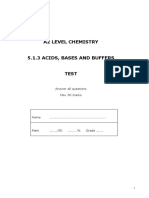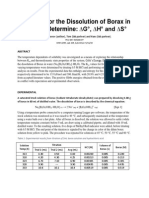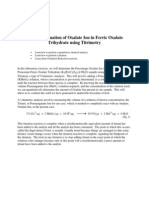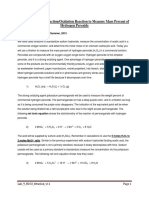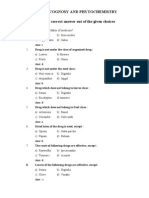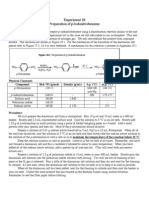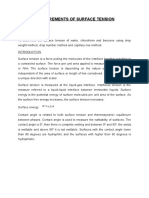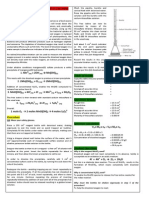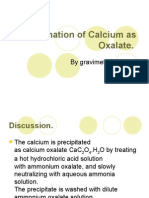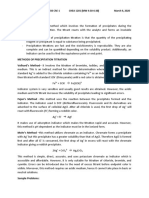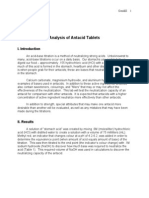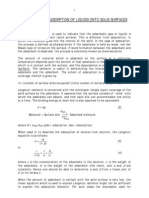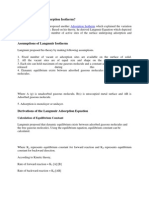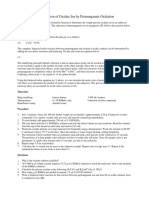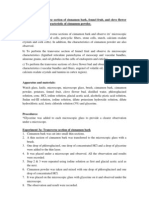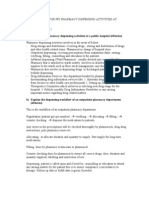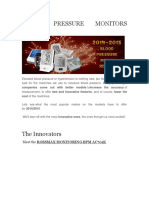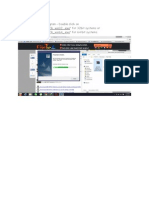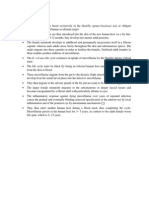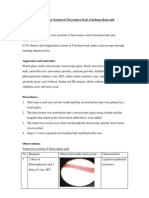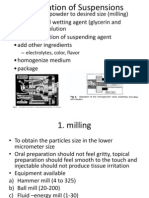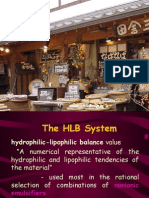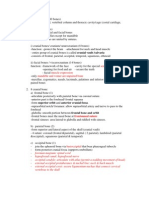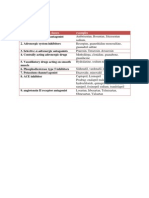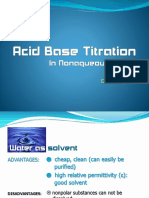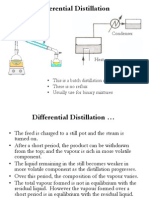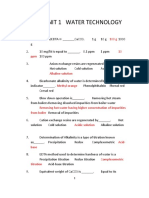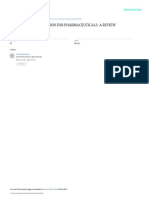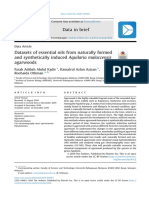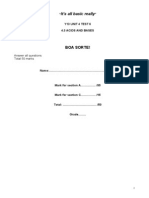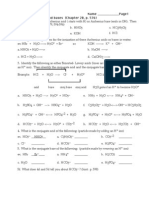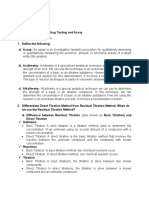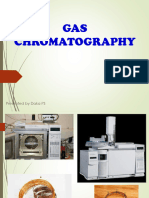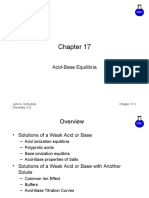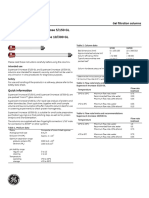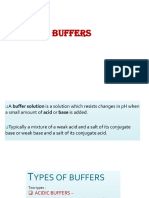Redox Titration
Redox Titration
Uploaded by
Ah BoonCopyright:
Available Formats
Redox Titration
Redox Titration
Uploaded by
Ah BoonCopyright
Available Formats
Share this document
Did you find this document useful?
Is this content inappropriate?
Copyright:
Available Formats
Redox Titration
Redox Titration
Uploaded by
Ah BoonCopyright:
Available Formats
Redox Titration: The Standardization of Potassium Permanganate
Lab Objectives: Titration Using a Primary Standard, Oxidation/Reduction Titration Equipment and Materials: magnetic stirrer / hotplate, stir bar, 50cc buret with stand and clamp, 400mL beaker, weigh boat, analytical balance, ~0.02M KMnO4 , reagent grade Na2C2O4 , 100mL graduated cylinder, 6.0M H2SO4 Sodium oxalate is commonly used as a primary standard for determining the concentration of many strong oxidizers used in oxidation/reduction analyses. In this experiment, sodium oxalate will be used to determine the concentration of the strong oxidizer potassium permanganate. Sodium oxalate, Na2C2O4, is a strong electrolyte that dissociates completely in water according to the following equation: Na2C2O4 2 Na+ (aq) + C2O42- (aq) The oxalate ion, C2O42-, will react quantitatively with permanganate ion, MnO4-, in the presence of strong acid according to the following equation: 2 MnO4- (aq) + 5 C2O42- (aq) + 16 H+ (aq) 2Mn2+ (aq) + 10 CO2 (g) + 8 H2O The numerical value of Keq for the equilibrium is very large. When reaction conditions are anywhere near optimum (in terms of pH and temperature) the reaction can be considered to be quantitative. Procedure 1. 2. 3. 4. 5. 6. 7. Transfer 200mL of water to a 400mL (or larger) beaker. Place the beaker on a magnetic stirrer/hotplate, add a stir bar, and start the stirrer on slow speed. If a magnetic stirrer is not available the solution can be stirred by hand with a stirring rod. Add 40mL of 6.0M sulfuric acid to the water. CAUTION: Sulfuric acid is extremely corrosive. Turn on the heater (full on). Monitor the temperature with a thermometer. You will need to heat the acid solution to about 80oC to 90oC. Continue with the procedure while the acid solution is heating. Use an analytical balance to mass 0.20g to 0.25g (NO MORE!) of reagent grade sodium oxalate in a weigh boat. Record the mass of sodium oxalate on the data sheet. Record the value to the nearest 0.0001g. Transfer the sodium oxalate sample to the acid solution. You may use a water bottle to facilitate the transfer if necessary. Rinse a buret with a few milliliters of the potassium permanganate solution. Dispose of the permanganate waste as directed by your teacher. Fill the buret with the permanganate solution above the zero mark. Drain the buret until the liquid level reads exactly zero. Make sure all the air is expelled from the tip of the buret. Mount the buret in a buret stand and position the buret over the acid/oxalate solution. Once the temperature of the acid/oxalate solution has reached the desired 80oC to 90oC range turn off the heater. Rapidly add ~5mL of the permanganate titrant and allow the solution to stir until the purple color disappears.
8. 9.
10. Continue the titration dropwise. Position the burets stopcock so that the permanganate titrant drips at a moderate pace. Do not allow the titrant to pour rapidly beyond the first five mLs. 11. As the titration approaches its equivalence point the purple color from the permanganate will persist longer and longer before it disappears. 12. Slow the rate of titration as the equivalence point is approached.
UAH Science in Motion
13. Immediately stop the titration when you believe the equivalence point is reached. The equivalence point is defined as the point in the titration where the color from the titrant persists for 30 seconds. A perfect titration will yield a faint pink solution that persists for a few minutes. 14. If the color fades before the 30 second requirement add more titrant one drop at a time until the 30 second requirement is reached. 15. Once you are satisfied the equivalence point has been reached record the volume of titrant (to the nearest 0.1mL) on the data sheet .
Calculations: 1. 2. 3. Calculate the moles of Na2C2O4 in your sample. Record this value on the data sheet. The molar mass of Na2C2O4 is 134.00g. The stoichiometric ratio between oxalate and permanganate is 5:2. Use this to find the moles of MnO 4- need to react with the moles of C2O42- in your sample. Record this value on the data sheet. Calculate the molarity of the permanganate solution. Record this value on the data sheet.
UAH Science in Motion
Data Sheet A. Mass of Na2C2O4 = _____________________g (Record to nearest 0.0001g) B. Volume of KMnO4 used = ___________________mL (Record to nearest 0.1mL) C. Moles of Na2C2O4 = _____________________mol D. Moles of KMnO4 = _____________________mol
E. Molarity of KMnO4 =____________________M
Questions: 1. 2. 3. 4. 5. 6. Why is it necessary to perform the titration in strong acid? Speculate on what would happen if the titration were attempted in neutral or basic conditions. Why is it necessary to heat the solution? Why is it necessary to make sure all air is removed from the tip of the buret? Write an expression for the equilibrium constant of the reaction. Define the term primary standard.
UAH Science in Motion
Questions: 1. Why is it necessary to perform the titration in strong acid? A: The equation tells us that 16 moles of H+ are consumed for every 5 moles of sodium oxalate and 2 moles of potassium permanganate. Without an excess of strong acid the equilibrium positions of the reactants would remain very large relative to the equilibrium positions of the products. 2. Speculate on what would happen if the titration were attempted in neutral or basic conditions. A: The rate of the forward reaction would be near zero. Essentially no apparent reaction would occur. 3. Why is it necessary to heat the solution? A: To facilitate the removal of the gaseous CO2 product. At room temperature buildup of CO2 in the solution would tend to retard the forward rate of the reaction. 4. Why is it necessary to make sure all air is removed from the tip of the buret? A: To prevent volume measurement error in the experiment. If the tip is not cleared of air in the beginning but gets cleared during the experiment Veq will be overstated. 5. Write an expression for the equilibrium constant of the reaction.
6.
Define the term primary standard. A: A primary standard is a reagent grade solid that reacts quantitatively with some component of a solution. This allows for the direct computation of the concentration of the solution component given the mass of the primary standard and the volume of the solution required for complete reaction.
UAH Science in Motion
You might also like
- F325 Acids, Bases and Buffers TestDocument12 pagesF325 Acids, Bases and Buffers TestSigourney MarshNo ratings yet
- Experiment 3 Redox Titration Percent Purity AnalysisDocument5 pagesExperiment 3 Redox Titration Percent Purity AnalysisnanaNo ratings yet
- Gravimetric Determination of Moisture CoDocument5 pagesGravimetric Determination of Moisture CoDEFIN BIMA REYNANDANo ratings yet
- 7 Neutralization TitrationsDocument32 pages7 Neutralization TitrationsnidsNo ratings yet
- Using KSP For The Dissolution of Borax in Water To Determine: G°, H° and S°Document4 pagesUsing KSP For The Dissolution of Borax in Water To Determine: G°, H° and S°Valentin-AngeloUzunov100% (18)
- Determination of Fluoride Concentration Using Ion Selective ElectrodeDocument7 pagesDetermination of Fluoride Concentration Using Ion Selective ElectrodeAmanda WangNo ratings yet
- Oxalate TitrationDocument10 pagesOxalate Titrationlushu851648No ratings yet
- Hydrogen Peroxide Analysis-4Document8 pagesHydrogen Peroxide Analysis-4Aurenio RibeiroNo ratings yet
- MCQ in Pharmacognosy and PhytochemistryDocument42 pagesMCQ in Pharmacognosy and PhytochemistryHarish Kakrani84% (195)
- KHP LabDocument5 pagesKHP LabSantino MusaNo ratings yet
- Experiment #5 Lab ReportDocument5 pagesExperiment #5 Lab ReportAlisher AbdugalimovNo ratings yet
- Experiment 18 Preparation of P-IodonitrobenzeneDocument3 pagesExperiment 18 Preparation of P-IodonitrobenzeneZarba KhanNo ratings yet
- Lab 4 - Cod TestDocument5 pagesLab 4 - Cod TestMohd Syafiq AkmalNo ratings yet
- Gravimetric Determination of SO3 in A SoDocument14 pagesGravimetric Determination of SO3 in A SoEdcelPerlacio100% (2)
- Measurements of Surface TensionDocument11 pagesMeasurements of Surface TensionHema ParasuramanNo ratings yet
- Chemistry Lab 3 Final DocumentDocument12 pagesChemistry Lab 3 Final DocumentshanonintegrityNo ratings yet
- Neutralisation Capacity of Commercial Antacid TabletDocument6 pagesNeutralisation Capacity of Commercial Antacid TabletEmmilia25% (4)
- Preparation of A Standard Acid SolutionDocument4 pagesPreparation of A Standard Acid SolutionfaithNo ratings yet
- Chapter 16 ADocument30 pagesChapter 16 AAbhishek Isaac MathewNo ratings yet
- Iron Determination, SpectrophotometricDocument2 pagesIron Determination, SpectrophotometricNiaz Ali KhanNo ratings yet
- Organic Qualitative AnalysisDocument54 pagesOrganic Qualitative AnalysisKojo EghanNo ratings yet
- Lab 3: AlkalinityDocument7 pagesLab 3: Alkalinityabulyalee0% (1)
- Double TitrationDocument3 pagesDouble TitrationBrent Alexis Dalistan100% (1)
- Acid-Base Equilibria and ApplicationDocument32 pagesAcid-Base Equilibria and Applicationfechem92100% (1)
- Experiment 1 Lab ReportDocument32 pagesExperiment 1 Lab ReportDI LacsonNo ratings yet
- Acid Base TitrationDocument7 pagesAcid Base TitrationAinul Diyana100% (1)
- Experiment 1Document5 pagesExperiment 1Joe CslNo ratings yet
- Dissolved Oxygen by Redox TitrationDocument2 pagesDissolved Oxygen by Redox TitrationSuet Wan GohNo ratings yet
- Simple Mixtures Colligative Properties: Chapter 7: SlideDocument32 pagesSimple Mixtures Colligative Properties: Chapter 7: SlideputriNo ratings yet
- Titration Curves of Strong and Weak Acids and BasesDocument3 pagesTitration Curves of Strong and Weak Acids and BasesMatthew Runyon50% (2)
- Determination of Calcium As OxalateDocument17 pagesDetermination of Calcium As Oxalateasep wandi nugraha100% (1)
- Ethyl Acetate Kinetics 2011Document9 pagesEthyl Acetate Kinetics 2011Paola moreno100% (1)
- Experiment 8Document4 pagesExperiment 8api-252952453100% (3)
- CHEM 334L - Conductance of Solutions - Estimating K For A Weak AcidDocument4 pagesCHEM 334L - Conductance of Solutions - Estimating K For A Weak Acidfdobonat613100% (1)
- Redox TitrationDocument70 pagesRedox TitrationIlham Krisdarmawan Putra100% (1)
- Chemical Oxygen DemandDocument4 pagesChemical Oxygen Demandbigstar42100% (1)
- Objectives: FIGURE A: Example of Coordination CompoundsDocument7 pagesObjectives: FIGURE A: Example of Coordination CompoundsNurul izzatiNo ratings yet
- Precipitation TitrationDocument3 pagesPrecipitation TitrationBanana SenpaiNo ratings yet
- Analysis of A Mixture of Carbonate and BicarbonateDocument2 pagesAnalysis of A Mixture of Carbonate and BicarbonateCharles Trono RacadioNo ratings yet
- Titration Lab ReportDocument5 pagesTitration Lab ReportvaiNo ratings yet
- Sample Kinetics ExperimentDocument7 pagesSample Kinetics ExperimentVenus PondevidaNo ratings yet
- CHM256 - Tutorial 5Document2 pagesCHM256 - Tutorial 5Fatimah Azzahrah0% (1)
- Experiment 3 - Determination of Density PDFDocument6 pagesExperiment 3 - Determination of Density PDFOxford North100% (1)
- 07 - Determining Molar Mass by Freezing Point DepressionDocument4 pages07 - Determining Molar Mass by Freezing Point DepressionStephanie Robertshaw0% (1)
- Joshua Haholongan - Science Rate of Reaction ReportDocument13 pagesJoshua Haholongan - Science Rate of Reaction ReportJoshua HaholonganNo ratings yet
- Antacid Analysisrty4Document4 pagesAntacid Analysisrty4Melced BenasasNo ratings yet
- Solubility Product ReportDocument28 pagesSolubility Product ReportYuli Astuti X TigaNo ratings yet
- Ion-Selective Electrode Determination of Fluoride Ion: Chemistry 321L ManualDocument5 pagesIon-Selective Electrode Determination of Fluoride Ion: Chemistry 321L Manuallsueyin100% (1)
- BOD Lab Report (Full)Document15 pagesBOD Lab Report (Full)Syamimi Fsa100% (1)
- Electrochemistry and ThermodynamicsDocument7 pagesElectrochemistry and ThermodynamicsAhmadPraboeNo ratings yet
- Gravimetric Determination of Moisture and Phosphorus Content in Fertilizer SamplesDocument8 pagesGravimetric Determination of Moisture and Phosphorus Content in Fertilizer SamplesanaperturescienceNo ratings yet
- 04 Script Examples Solid Liquid ExtractionDocument11 pages04 Script Examples Solid Liquid ExtractionLei YinNo ratings yet
- Chm312 AasDocument9 pagesChm312 Aassarah qistina100% (1)
- CHM 421 Exp 3Document6 pagesCHM 421 Exp 3EmmiliaNo ratings yet
- Experiment 2 - Adsorption of Liquids Onto Solid Surfaces: TheoryDocument3 pagesExperiment 2 - Adsorption of Liquids Onto Solid Surfaces: TheoryfrankjenNo ratings yet
- Acid Base Titration by The Sodium Carbonate Method Determining The Total Alkaline Strength of Soda AshDocument2 pagesAcid Base Titration by The Sodium Carbonate Method Determining The Total Alkaline Strength of Soda AshMichael GuinitaNo ratings yet
- What Is Langmuir Adsorption IsothermDocument5 pagesWhat Is Langmuir Adsorption Isothermalimisaghian62No ratings yet
- Spectrophotometric Determination of The Equilibrium Constant of A Reaction Chem 17Document7 pagesSpectrophotometric Determination of The Equilibrium Constant of A Reaction Chem 17Frances Abegail QuezonNo ratings yet
- Chemical Reaction Kinetics: Concepts, Methods and Case StudiesFrom EverandChemical Reaction Kinetics: Concepts, Methods and Case StudiesNo ratings yet
- Determination of Oxalate Ion by Permanganate OxidationDocument1 pageDetermination of Oxalate Ion by Permanganate Oxidationthrowaway456456No ratings yet
- TitrationDocument10 pagesTitrationhao GamesNo ratings yet
- Narcolepsy and CataplexyDocument6 pagesNarcolepsy and CataplexyAh BoonNo ratings yet
- Practical 3Document6 pagesPractical 3Ah Boon100% (2)
- Emotional: Anger, Also Known As Wrath orDocument1 pageEmotional: Anger, Also Known As Wrath orAh BoonNo ratings yet
- LofralDocument10 pagesLofralAh BoonNo ratings yet
- Answer Schemes For Pp3 Pharmacy DispensingDocument2 pagesAnswer Schemes For Pp3 Pharmacy DispensingAh BoonNo ratings yet
- Blood Pressure Monitors ReviewDocument14 pagesBlood Pressure Monitors ReviewAh BoonNo ratings yet
- Step 1Document6 pagesStep 1Ah BoonNo ratings yet
- Pathogen Es IsDocument5 pagesPathogen Es IsAh BoonNo ratings yet
- Practical 1Document6 pagesPractical 1Ah BoonNo ratings yet
- Practical 2Document6 pagesPractical 2Ah BoonNo ratings yet
- Case Study - Group 5-Sem 4Document36 pagesCase Study - Group 5-Sem 4Ah BoonNo ratings yet
- Pharmaceutical Suppositories & PessariesDocument34 pagesPharmaceutical Suppositories & PessariesAh Boon100% (1)
- Preparation of SuspensionsDocument4 pagesPreparation of SuspensionsAh BoonNo ratings yet
- HLB2Document41 pagesHLB2Ah BoonNo ratings yet
- OintmentsDocument29 pagesOintmentsAh BoonNo ratings yet
- Homogeneous OintmentsDocument25 pagesHomogeneous OintmentsAh BoonNo ratings yet
- Epidemiology Study DesignsDocument16 pagesEpidemiology Study DesignsAh Boon100% (1)
- Applications of Mutual ProdrugDocument4 pagesApplications of Mutual ProdrugAh BoonNo ratings yet
- Vertebrae To The Skull: Frontonasal SutureDocument8 pagesVertebrae To The Skull: Frontonasal SutureAh BoonNo ratings yet
- Antihypertension Drug ClassesDocument1 pageAntihypertension Drug ClassesAh BoonNo ratings yet
- 3 - Acid Base Titration in Nonaqueous - DSWDocument27 pages3 - Acid Base Titration in Nonaqueous - DSWbrianNo ratings yet
- Unit - Ii Crystalstructure Analysis: - Analysis of Diffraction Patterns - Inter Planer SpacingDocument29 pagesUnit - Ii Crystalstructure Analysis: - Analysis of Diffraction Patterns - Inter Planer SpacingpariNo ratings yet
- Defects in The Crystal Structure of MetalsDocument10 pagesDefects in The Crystal Structure of MetalsSahin KerimliNo ratings yet
- Differential DistillationDocument8 pagesDifferential DistillationIsuru Lakmuthu MudannayakeNo ratings yet
- Pseudoephedrine Hydrochloride Carbinoxamine Maleate and Dextromethorphan Hydrobromide Oral SolutionDocument2 pagesPseudoephedrine Hydrochloride Carbinoxamine Maleate and Dextromethorphan Hydrobromide Oral SolutionK.m. Ehsan Morshed RanaNo ratings yet
- Buffer and Solution PreparationDocument3 pagesBuffer and Solution PreparationRabia Gül AydınNo ratings yet
- CHM Unit 1 & 2 Mcq'sDocument15 pagesCHM Unit 1 & 2 Mcq'sC - 01 ÃshwinNo ratings yet
- Silica, LR, Method 8186, 02-2009, 9th EdDocument5 pagesSilica, LR, Method 8186, 02-2009, 9th EdthanhhuyenNo ratings yet
- Chap 06Document25 pagesChap 06echelon120% (1)
- 21.RPA1300143 MyarticleDocument13 pages21.RPA1300143 Myarticlevarsha02jadhavNo ratings yet
- Application Note - Using THGA and Zeeman Background Correction For Blood-Lead Determination in Customer-Validated ApplicationsDocument4 pagesApplication Note - Using THGA and Zeeman Background Correction For Blood-Lead Determination in Customer-Validated ApplicationsNguyễnHoàngDanhNo ratings yet
- Datasets of Essential Oils From Naturally Formed and Synthetically Induced Aquilaria Malaccensis AgarwoodsDocument4 pagesDatasets of Essential Oils From Naturally Formed and Synthetically Induced Aquilaria Malaccensis AgarwoodsRiza RinjaniNo ratings yet
- CH-314 Lab Experiment 5Document4 pagesCH-314 Lab Experiment 5Fatima tahirNo ratings yet
- Bronsted Final - Roy TiapeDocument10 pagesBronsted Final - Roy TiapeJerbs PacundoNo ratings yet
- 4.3 TestDocument8 pages4.3 TestOriginaltitleNo ratings yet
- Purification of Proteins Using Ion Exchange Chromatography and Gel Filtration Chromatography PDFDocument4 pagesPurification of Proteins Using Ion Exchange Chromatography and Gel Filtration Chromatography PDFIza SalvadorNo ratings yet
- Potentiometric TitulationsDocument18 pagesPotentiometric Titulationslilipu0% (1)
- Acidbase L207Document5 pagesAcidbase L207silvergold888No ratings yet
- Protolytic Equilibriaof Picric AcidDocument7 pagesProtolytic Equilibriaof Picric AcidMuhammad Fiqih AlayubiNo ratings yet
- AcidimetryDocument2 pagesAcidimetryMaiden Joy UtaydeNo ratings yet
- Gas ChromatographyDocument59 pagesGas Chromatographyfranklin ChikuwaNo ratings yet
- Chemical EquilibriumDocument23 pagesChemical EquilibriumArihant BedagkarNo ratings yet
- Crow, David Richard - Principles and Applications of Electrochemistry-Blackie Academic (1996)Document295 pagesCrow, David Richard - Principles and Applications of Electrochemistry-Blackie Academic (1996)Hoàng HyNo ratings yet
- Acid-Base Equilibria: John A. Schreifels Chemistry 212 Chapter 17-1Document26 pagesAcid-Base Equilibria: John A. Schreifels Chemistry 212 Chapter 17-1Alaa Al HamedNo ratings yet
- Superose Tricorn Column Manual - EDDocument8 pagesSuperose Tricorn Column Manual - EDclovekvzeselzopiceNo ratings yet
- Present and Future Challenges in Food Analysis: Foodomics: Supporting InformationDocument10 pagesPresent and Future Challenges in Food Analysis: Foodomics: Supporting InformationAna RebeloNo ratings yet
- Buffer and Isotonic SolutionDocument25 pagesBuffer and Isotonic SolutionShipra Singhal100% (2)
- Experiment 9: Direct Titration of Lead With Eriot and Edta SynopsisDocument2 pagesExperiment 9: Direct Titration of Lead With Eriot and Edta SynopsisAhmed AliNo ratings yet
- ATAR Chemistry Revision Booklet 2022Document51 pagesATAR Chemistry Revision Booklet 2022josh soonNo ratings yet
- 1 Notes ChemomatricsDocument20 pages1 Notes ChemomatricsAyesha MuhaddisNo ratings yet
